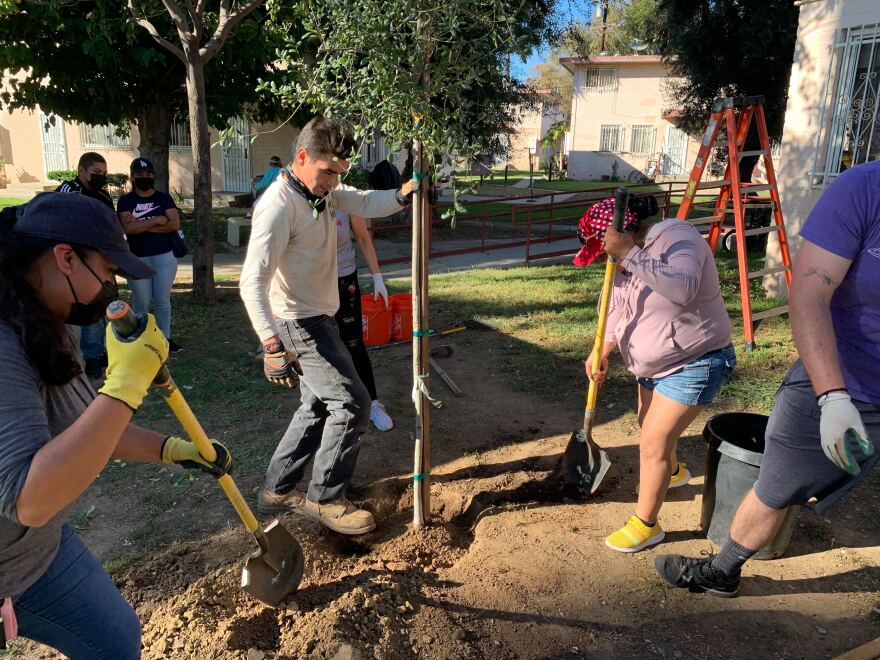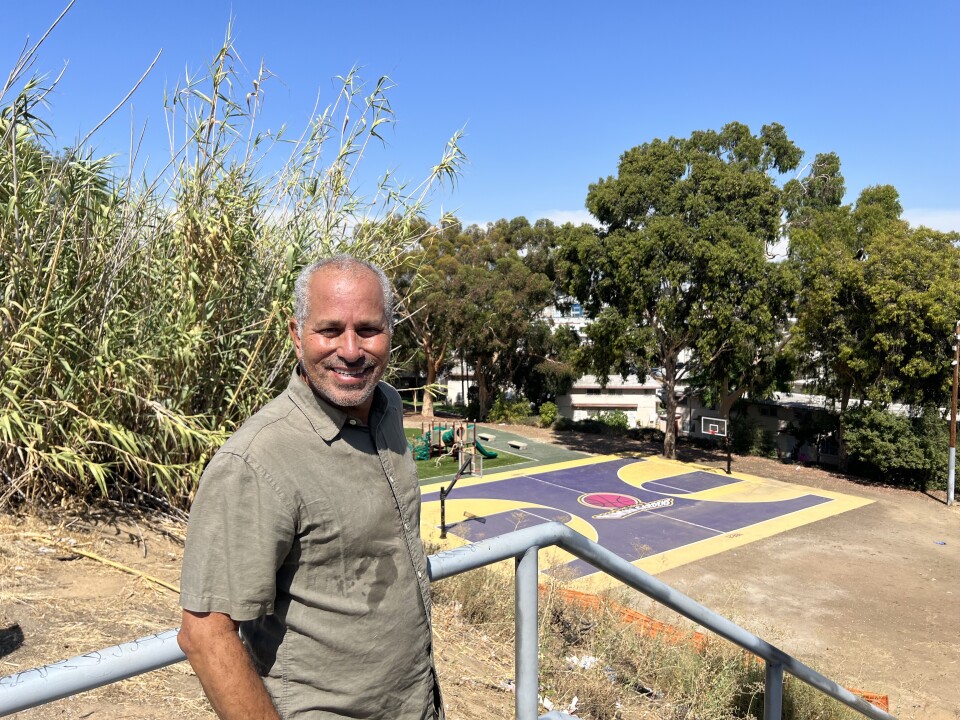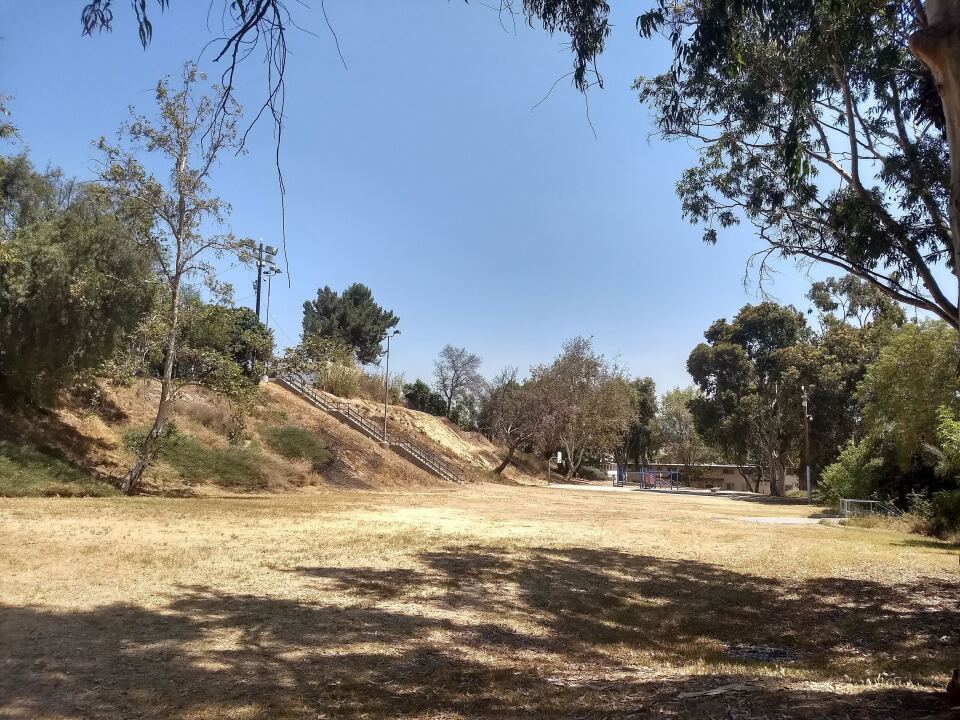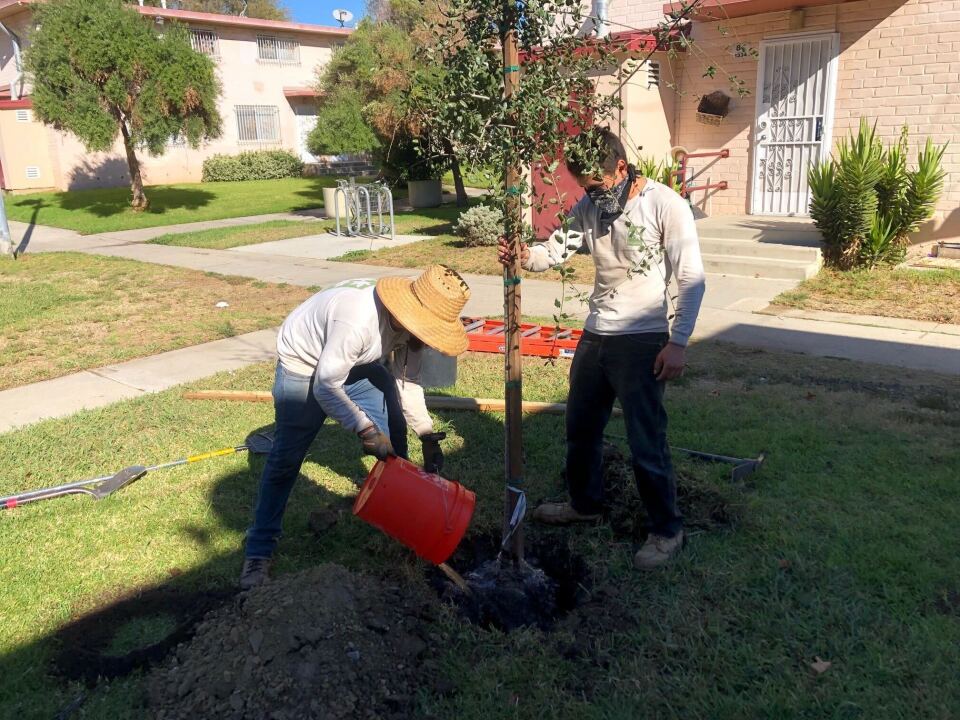Truth matters. Community matters. Your support makes both possible. LAist is one of the few places where news remains independent and free from political and corporate influence. Stand up for truth and for LAist. Make your year-end tax-deductible gift now.
How To Make LA Greener One Tree (And Park) At A Time

In Los Angeles, the lack of green space is real.
One out of four people killed by extreme heat in L.A. could be saved if more trees were planted in the region, according to a recent study from UCLA researchers.
Listen to the How to LA podcast
Catch up on the latest episode of the How to L.A. podcast, hosted by Brian De Los Santos, wherever you get your podcasts.
And research from UC Davis found disparities based on race and class: on a hot day in the city, the neighborhoods that are made up of mostly Latino residents can be more than six degrees hotter than others.
Aaron Thomas, director of urban forestry for the nonprofit North East Trees, says parks can make a difference.
“Every neighborhood needs more parks,” Thomas says. “Every person should be able to walk out their front door and go to some sort of park.”

For the last 30 years, his mission has been to make L.A. greener, because it’s not just nice for recreation and our dogs — it’s about public health. Trees help remove air pollution and reduce stress, among other benefits, contributing to our physical and mental well being.
“It's almost inevitable that the population is gonna continue to grow in L.A.,” Thomas says. “To have any meaningful quality of life, we need to have more parks everywhere, like in every neighborhood.”
Thomas and North East Trees have been planting trees around Ramona Gardens, a public housing development sandwiched between Boyle Heights, El Sereno, and Lincoln Heights, for decades now.
Over that time, he says they’ve hired and trained over a hundred Ramona Gardens residents to help change the landscape.
“There's no nature. This is surrounded by the 10 Freeway right there. The Metrolink, which is a diesel train, runs right through here.” Thomas says, “You don't have to be a genius or a scientist to know that the air quality is really, really poor in this neighborhood.”
Walking around the complex, Thomas points to all kinds of trees they planted: lemon, plum, orange, oak, olive. He says they help filter particulates out of the air and act as a buffer for the noise pollution from the trains and freeway.
Why So Little Green?
So with all these benefits, why does L.A. seem to have so few public parks?
It goes back to the way the region was designed, Thomas says.
“We’re a different kind of city. People want to move around the city in cars, in their own transportation.” he says. “People come here and they wanna settle and have their own little house.”
That means people were supposed to have their own green space at home, he says. But things didn’t quite develop like that.
L.A. started as a low-density community of single family homes, so policymakers didn’t invest in outdoor open space like they have in other cities, says Claire Nelischer, an urban planning doctoral student at UCLA.
“But as the city has become denser and more populous, the provision of park space really hasn't kept up with that growth,” she says.
Racism and classism has something to do with it too, she adds.
Whiter and wealthier communities generally have much better access to parks and open space in Los Angeles.
“Whiter and wealthier communities generally have much better access to parks and open space in Los Angeles,” Nelischer says. Based on her research, the existing parks in low-income neighborhoods and communities of color often don’t meet people's needs.
“In some cases there are maintenance issues or safety issues,” Nelischer says. “In other cases there are literal accessibility barriers … if there's no accessible transit routes or safe routes to access these parks, then folks won't use them.”
The Making Of A Park
Thomas is trying to make up for the historic deficit of parks with a new project at Ramona Gardens.
Right now, it just looks like a big dirt lot. But North East Trees got $1.2 million dollars from the California Natural Resources Agency, SoCal Gas and USC to turn the space into a basketball court, picnic area and native rain garden.

Over the next two years, Thomas says they plan to put in 300 new trees at Ramona Gardens, and close to 4,000 trees in the larger neighborhood.
“Some people might look at this and see a trashy, weed-filled hillside,” Thomas says. “I know that this is where kids play. They told me they climb on the rocks there. They should have a safe but enjoyable space to be out in nature and climb a hill like every kid should.”
Thomas says planting trees outside people’s homes at Ramona Gardens was just the beginning. His goal is to fix up the park, add trees and vines to a nearby alley, and connect residents to a bigger city park and bus lines. From there, he plans to create green pathways to Ascot Hills, an even bigger open space just north of Ramona Gardens.
“It's like a corridor — a nature corridor for this whole community,” he says.
Improvement Or Gentrification?
We know there’s inequality across neighborhoods when it comes to parks. Whiter and richer neighborhoods get more investment to create green spaces.
That’s why Thomas and North East Trees are focusing their efforts on low-income communities of color with projects in Boyle Heights, Lincoln Heights, Cypress Park, Watts, South Central L.A., Baldwin Hills, Florence Firestone, and Highland Park.

But, whether it’s rain gardens, bike lanes, or new housing, there can be an element of suspicion from residents when a neighborhood starts changing. Thomas says that hasn’t been a problem for him at Ramona Gardens.
“I personally have never seen the co-relationship between people taking care of the environment that they live in and ultimately being gentrified,” Thomas says. “I've never heard a large consensus of people tell me, please, don't plant trees in my neighborhood.”
In his experience, L.A. residents typically want help greening their neighborhoods. He says people from communities of color have started coming to him, asking for support.
If we collectively just make the effort to improve those conditions, is that a worthwhile effort? I think so.
“In low-income communities of color in L.A., the air quality is among the worst in the country as far as pollutants in the air, in the soil, in the water,” Thomas says. “If we collectively just make the effort to improve those conditions, is that a worthwhile effort? I think so.”
If you’re interested in getting involved with local restoration, there are other organizations across L.A. to check out. Here’s a list below:
(P.S. There's a audio version of this story, too. Check out the How to LA podcast.)







